How To Lock Android Phone Settings
Android Intelligence Advice
11 Android settings that'll strengthen your security
Android's own native security options aren't always obvious — simply they're absolutely worth your while to embrace and understand.
Yous might not know information technology from all the panic-inducing headlines out there, but Android is really packed with powerful and practical security features. Some are activated by default and protecting you whether yous realize it or non, while others are more out of the way simply equally deserving of your attention.
And so finish wasting your time worrying about the Android malware monster du jour and which security company is using it to scare you into an unnecessary subscription, and take a moment instead to look through these far more impactful Android security settings — ranging from cadre system-level elements to some more advanced and easily overlooked options.
Ready?
1. App permissions
A rarely spoken reality of Android security is that your own negligence — either in declining to properly secure your device in some manner or in leaving open too many windows that allow third-political party apps to access your info — is far more likely to exist problematic than whatever manner of malware or scary-sounding boogeyman.
And so let'due south accost the first part of that correct off the bat, shall we? Despite what some sensational stories might lead you to believe, Android apps are never able to access your personal data or any part of your telephone unless you explicitly give 'em the permission to do so. And while yous can't undo anything that's already happened (unless you happen to own a time-traveling DeLorean — in which case, great Scott, drop me a line), you can get back and revisit all your app permissions to make certain everything'due south in expert shape now.
That'southward appropriate to practice periodically, anyway, and particularly at present — as the last couple Android versions included some important new app permission options. Specifically, you lot can now let apps access your location just when they're actively in utilize, instead of all the time (as of Android ten) and corroborate certain permissions but on a i-time, express-utilise ground (every bit of Android 11). But any apps that were already on your phone by the fourth dimension those upgrades arrived would've already had full, unrestricted access to those areas of your device. And it'southward up to you to revisit 'em and update their settings as needed.
Then do this: Head into the Privacy section of your organisation settings and observe the "Permission manager" line. That'll show you a listing of all available system permissions, including specially sensitive areas such as location, camera, and microphone — the same three areas, incidentally, that can exist limited to quondam use only on whatever phone running Android xi. (And if you don't run across a "Permission manager" option on your telephone, try looking in the Apps section instead. You can so pull up one app at a time in that location and observe its permissions that fashion.)
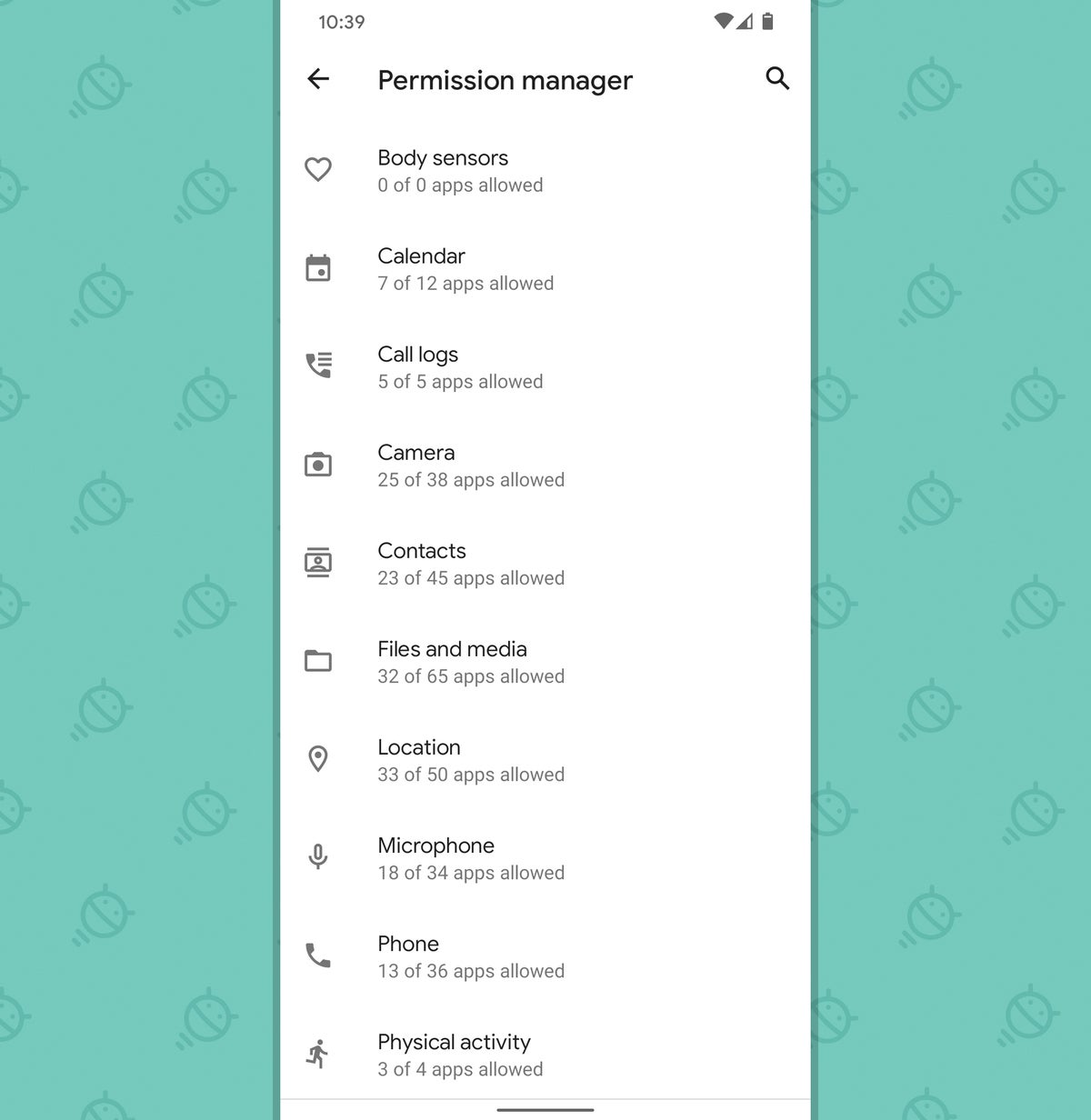 JR
JR Tap on a specific permission, and you lot'll see a breakdown of exactly which apps are authorized to use the permission in what way.
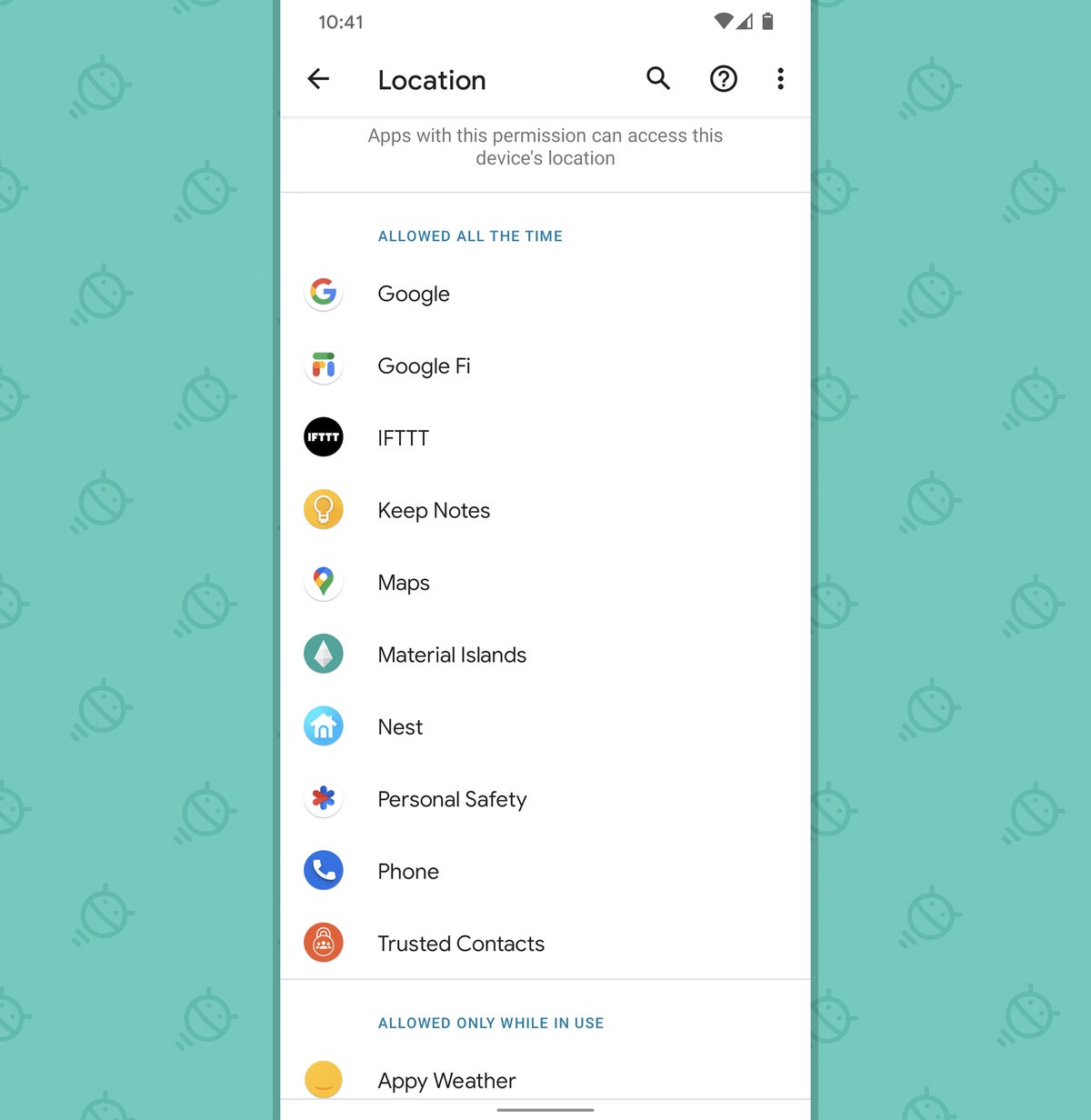 JR
JR You tin can then tap on any app to conform its level of access and bring it downward a notch, when applicable, or remove its access to the permission entirely.
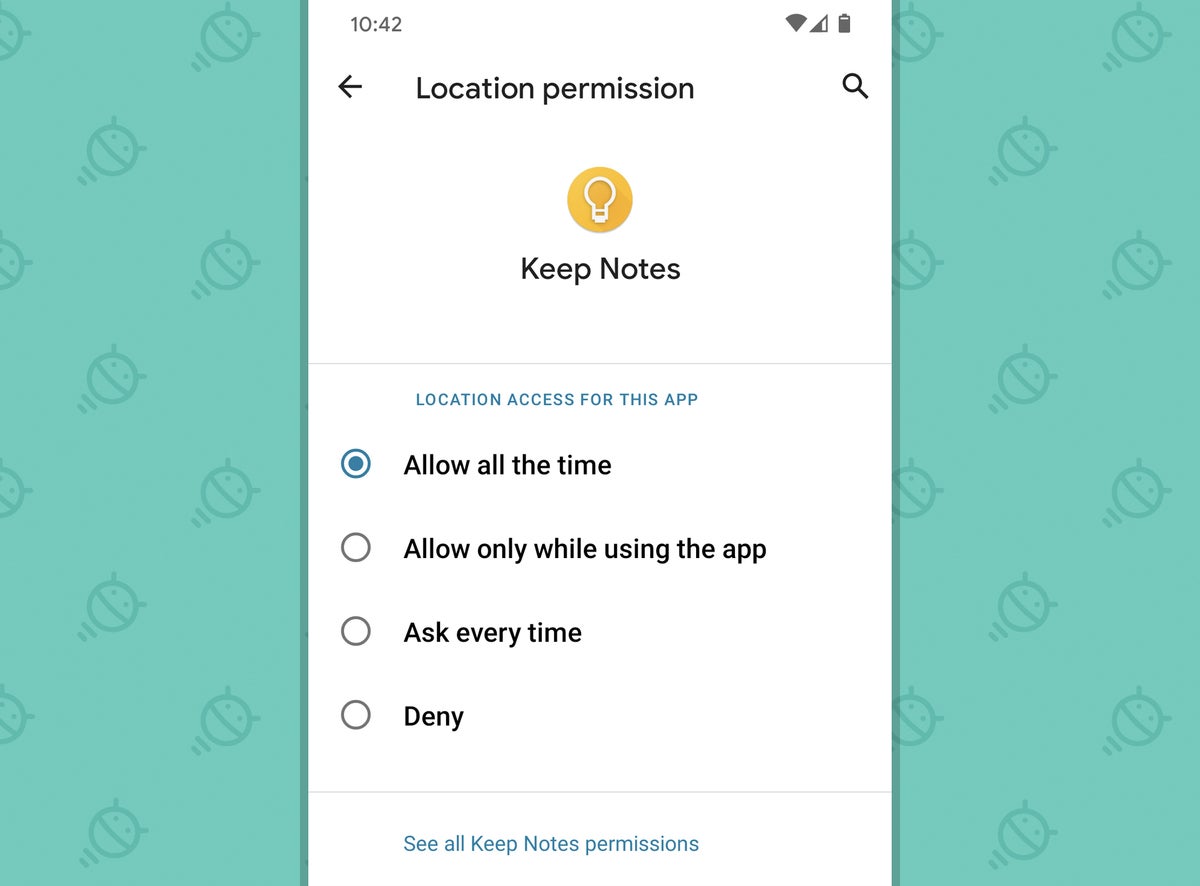 JR
JR If there's one section of Android security settings worth spending the time to revisit, this is without a dubiousness it.
ii. Google Play Protect
Speaking of apps on your telephone, this is a fine time to talk almost Google Play Protect — Android's native security organisation that, among other things, continuously scans your phone for whatsoever signs of misbehaving apps and warns you if anything suspicious emerges.
(And yes, information technology does sometimes fail to detect shady players immediately — something that gets played upward to a comedic caste in those misleading marketing campaigns — but even in those instances, the existent-world threat to most folks is typically quite minimal.)
Unless you lot (or someone else) inadvertently disabled it at some point, Play Protect should be up and running on your phone already — simply it certainly can't injure to double-cheque and make sure.
To do so, but open up the Security department of your Android organization settings. Tap the line labeled "Google Play Protect," and so tap the gear icon in the upper-right corner and make certain the toggles there are activated.
Back on the chief Play Protect screen, you'll come across a status update showing y'all that the system is agile and working. Information technology works entirely on its own, automatically, but you tin always trigger a transmission scan of your apps on that same folio, if yous're e'er so inclined (or maybe merely feeling slightly bored).
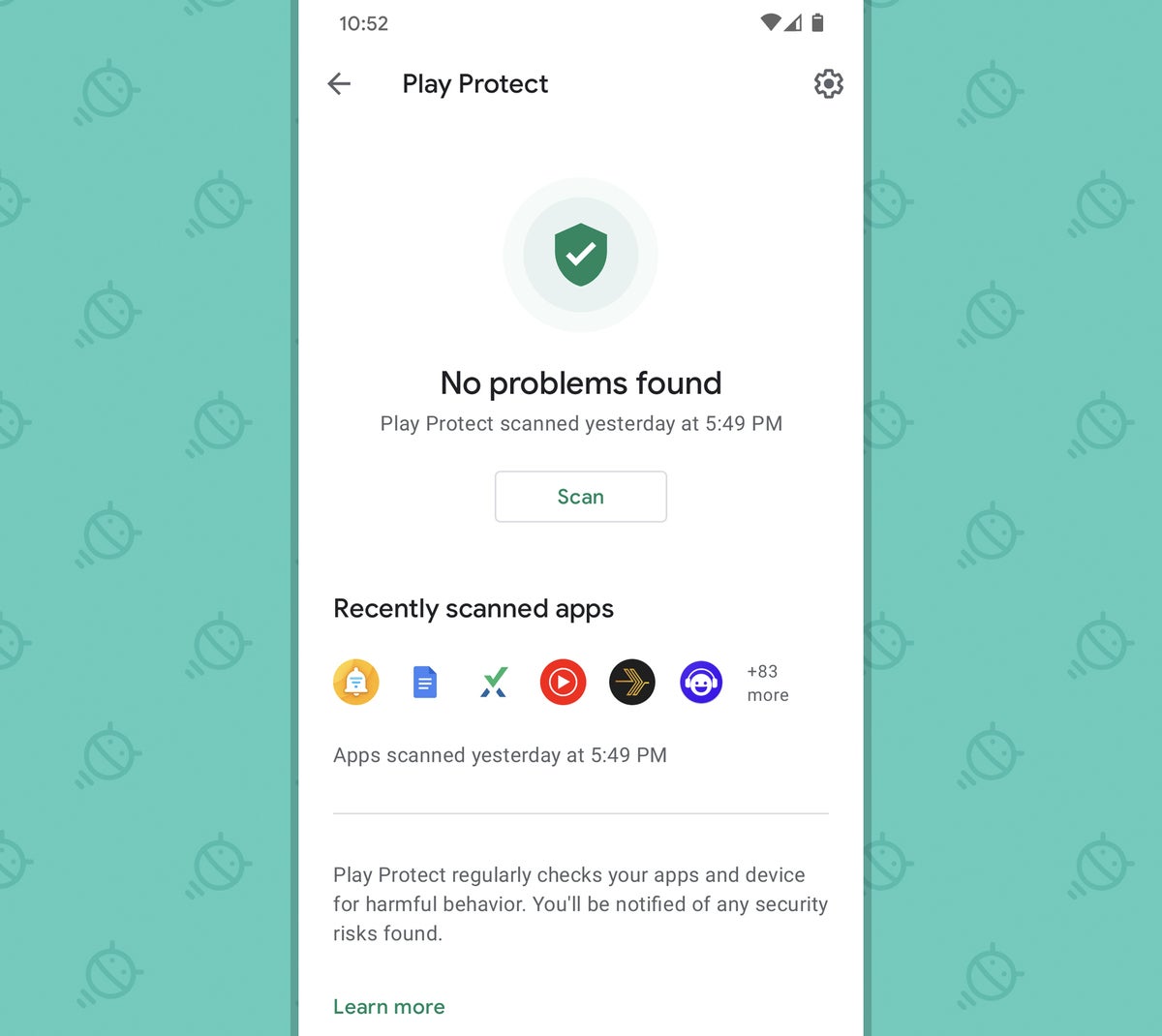 JR
JR 3. Rubber Browsing
Chrome is typically the default Android browser — and as long equally you're using it, yous can balance a niggling easier knowing it'll warn you someday you try to open a shady site or download something dangerous.
While Chrome's Condom Browsing mode is enabled by default, though, the app has a newer and more than effective version of the same system called Enhanced Safe Browsing. And it's up to you to enable and opt in to it.
You can read more than about what exactly Enhanced Safe Browsing is, why it might be advantageous to activate, and how you lot tin can get information technology up and running on your own device in this Chrome security column of mine from final calendar week.
iv. Lock screen limitations
If someone else ever gets their sweaty paws on your phone, y'all don't want them to be able to access whatsoever of your personal information — right?
Well, take note: Android typically shows notifications on your lock screen by default — which means the contents of emails or other messages y'all receive might be visible to anyone who looks at your device, fifty-fifty if they can't unlock it.
If yous tend to get sensitive messages or but desire to stride up your security and privacy game, you tin restrict how much notification info is shown on your lock screen by going to the Privacy section of your system settings, tapping the line labeled "Notifications on lock screen," and then changing its setting from "Show all notification content" to either "Show sensitive content only when unlocked" (which will filter your notifications and put only those accounted every bit "non sensitive" onto the lock screen) or "Don't show notifications at all" (which, every bit you'd expect, will not show any notifications on your lock screen whatsoever).
If you lot're using a Samsung phone, y'all'll find those same options within the dedicated Lock Screen section of the organization settings — though, unfortunately, with less nuance involved (as Samsung has for no apparent reason removed the "sensitive" notification differentiation from the settings on its version of Android).
And speaking of the lock screen...
5. Smart Lock
Security is only useful if yous really utilise it — and given the extra level of inconvenience information technology often adds into our lives, it'south all also easy to let our guards downwards and go lazy after a while.
Android's Smart Lock feature is designed to counteract that tendency by making security a teensy bit less abrasive. It can allow you lot automatically keep your telephone unlocked whenever yous're in a trusted place — like your home, your role, or that weird-smelling restaurant where you eat barbeque sandwiches well-nigh disgustingly often — or even when you're connected to a trusted Bluetooth device, like a smartwatch, some earbuds, or your car's audio system.
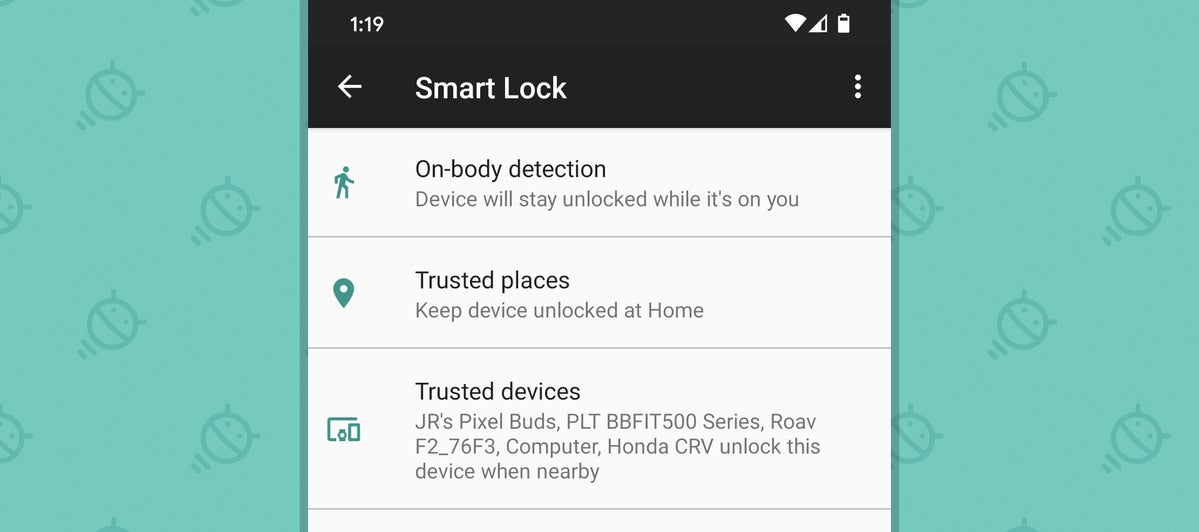 JR
JR Expect for the "Screen Lock" pick in the Security section of your system settings — or the Lock Screen section, on a Samsung telephone — to explore the possibilities. (And if you ever find the Trusted Places part of Smart Lock isn't working reliably, by the way, here's the threescore-second fix.)
6. Two-factor authentication
This next one's technically a Google business relationship feature and non specific to Android, but information technology'due south very much connected to Android and your overall smartphone security moving-picture show.
You know what two-factor authentication is by now, right? And you're using it everywhere you can — especially on your Google account, which is probably associated with all sorts of sensitive information? Right?!
If yous aren't, by golly, at present's the time to start. Hustle over to the Google department of your phone's system settings, tap "Manage your Google Account," and so scroll across that top row to select the "Security" tab. Find and tap "2-Step Verification" and follow the steps to ready things up.
For most people, I'd recommend using your telephone's ain "Security Primal" option equally the default method, if it's available, followed past "Google prompts" and an authenticator app equally secondary methods. For that last part, you'll need to download and prepare up an app like Google's own Authenticator or the more flexible Authy to generate your sign-in codes.
It'll add together an actress step into your sign-in process, but this is one area where the small inconvenience is very much worth the tradeoff for enhanced protection.
7. Lockdown mode
Provided you're using a telephone with Android 9 or college (and if you aren't, switching over to a current telephone that actually gets active software updates should be your top security priority!), an choice called lockdown mode is well worth your while to investigate. Once enabled, it gives you lot an easy way to temporarily lock down your telephone from all biometric and Smart Lock security options — meaning only a blueprint, PIN, or password can get a person past your lock screen and into your device.
The idea is that if you were ever in a situation where you thought you might be forced to unlock your telephone with your fingerprint or face — be it by some sort of law enforcement amanuensis or only past a regular ol' hooligan — you could activate the lockdown mode and know your information couldn't be accessed without your explicit permission. Even notifications won't show up on your lock screen when the mode is activated, and that heightened level of protection volition remain in identify until you manually unlock your telephone (even if the device is restarted).
The flim-flam, though, is that on certain phones — particularly those that shipped with earlier Android versions and were upgraded to Android ix at some point — yous have to enable the option ahead of time in order for information technology to exist available. To confirm that it'south activated on your device, open upwards your organization settings, search for the give-and-take lockdown, and brand sure the toggle aslope "Show lockdown choice" is set into the on position.
With that enabled, y'all should see a control labeled either "Lockdown" or "Lockdown mode" someday yous press and hold your phone'south power button. With any luck, y'all'll never need it. Merely it's a good added layer of protection to have bachelor, just in case — and at present you know how to find it.
8. Screen pinning
One of Android'south almost practical security options is also one of its virtually subconscious features. I'm talking most screen pinning — something introduced manner back in 2022's Lollipop era and rarely mentioned since.
Screen pinning makes information technology possible for yous to lock a single app or process to your phone and and then require a password or fingerprint authentication before annihilation else tin be accessed. Information technology can be invaluable when you lot pass your telephone off to a friend or colleague and want to be sure they don't accidentally (or maybe not so accidentally) get into something they shouldn't.
To use screen pinning, you lot'll get-go need to activate it by opening that trusty ol' Security section in your primary organization settings and and then finding the line labeled "Screen pinning." (You'll probably have to tap a line labeled "Advanced" or "Other security settings" in order to reveal it.) Plow the feature on and also brand certain the toggle to "Ask for unlock pattern earlier unpinning" is activated.
At present, the adjacent time you're about to place your telephone in someone else'south hands, first open up your system Overview interface — either by swiping up from the lesser of your screen and holding your finger downwardly, if you lot're using Android's gesture system, or by pressing the square-shaped button, if you lot're even so hanging onto the former-school three-button nav setup.
On any phone running reasonably recent software, you'll then tap the icon of the app you want to pin, direct above its menu in that Overview area. And there, you lot should see the Pin option.
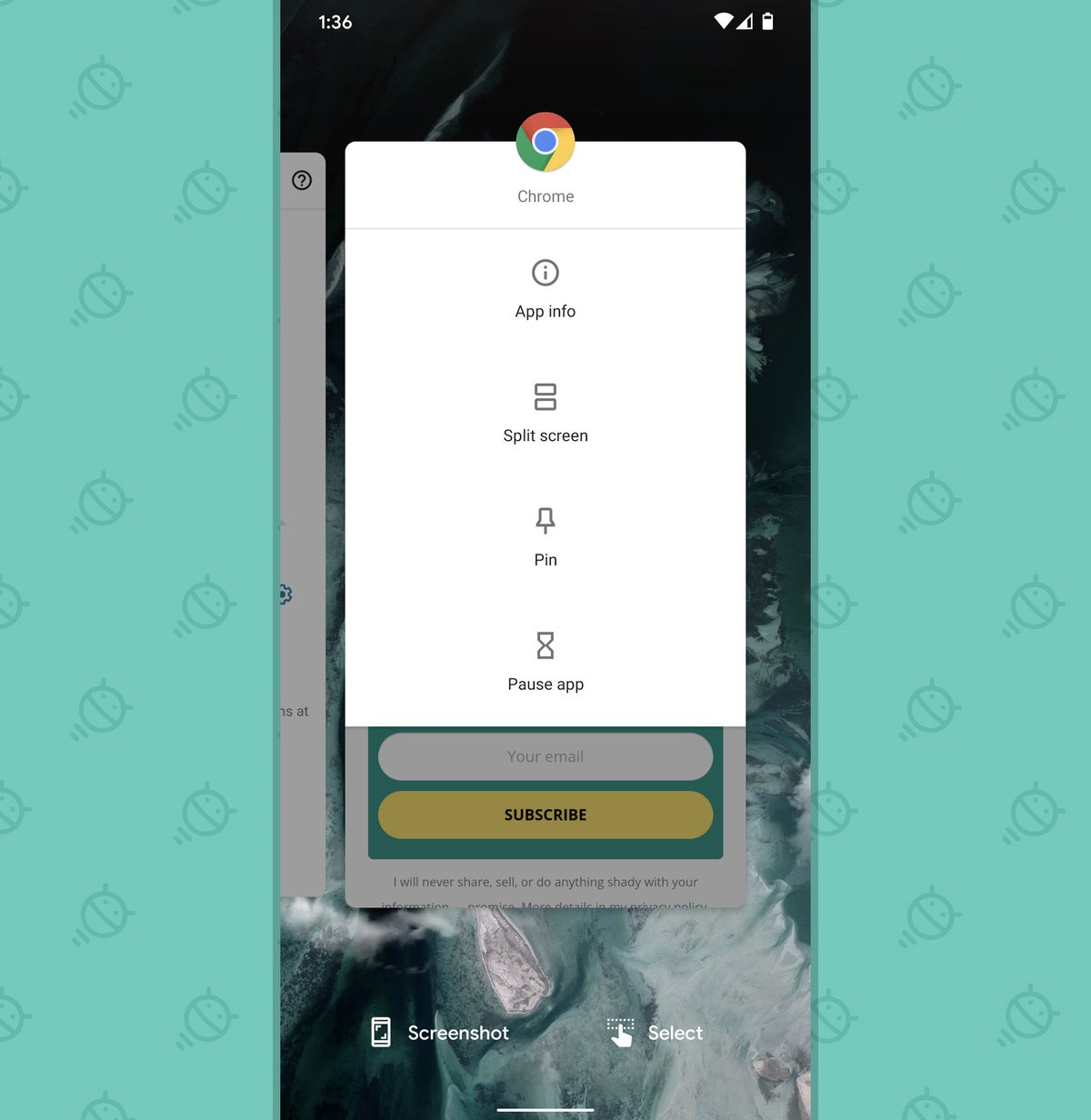 JR
JR In one case you lot've tapped that, you won't exist able to switch apps, go back to your home screen, look at notifications, or practise anything else until you exit the pinning and unlock the device. To practice that, with gestures, you'll swipe upwardly from the bottom of your screen and concord your finger down — and with the old iii-push button nav setup, y'all'll printing the Back and Overview buttons at the same fourth dimension.
nine. Guest Mode
If you lot want to go a stride further and let someone else use all parts of your phone without always encountering your personal information or being able to mess anything up, Android has an incredible system that'll permit you lot do only that — with next to no ongoing endeavour involved.
Information technology'southward called Guest Way, and information technology'due south been effectually since 2022, despite the fact that well-nigh folks have completely forgotten well-nigh information technology. For a detailed walkthrough of what it'south all nearly and how you can put it to use, see my carve up Android Guest Way guide from a few weeks back.
10. Find My Device
Whether you've simply misplaced your phone around the house or office or you've really lost information technology out in the wild, always remember that Android has its ain built-in machinery for finding, ringing, locking, and fifty-fifty erasing a device from afar.
Similar Play Protect, the Android Notice My Device characteristic should be enabled by default. You can brand certain by heading into the Security section of your organization settings and borer the line labeled "Find My Device." Double-cheque that the toggle at the superlative of the screen is turned on.
Using a Samsung phone? Samsung provides its own superfluous, redundant service called Find My Mobile, merely the native Google Android version volition bring all of your devices together into a unmarried place — not but those made by Samsung — and is likewise more than versatile in how and where information technology's able to work. On a Samsung device, the easiest way to observe the Android Observe My Device setting is to search your arrangement settings for the phrase Observe My Device.
In one case you've confirmed the setting is enabled, if y'all e'er need to track your telephone downwards, just go to android.com/find from whatsoever browser or do a Google search for "discover my device." (There's as well an official Detect My Device Android app, if you have another Android device and want to keep that function standing by and gear up.)
As long equally you're able to sign into your Google business relationship, y'all'll be able to pinpoint your phone's last known location on a map and manage it remotely inside a affair of seconds.
11. Emergency contact info
Find My Device is a fantastic resource to have — only in certain situations, you might get a missing phone back fifty-fifty faster with the help of a fellow man.
Give people a risk to do the right affair by calculation an emergency contact that can be accessed and dialed with a few quick taps from your lock screen. To start, go to the Virtually Phone section of your system settings, then find and tap the line labeled "Emergency information."
Tap the appropriate line and follow the prompts to add together an emergency contact — a shut friend, family fellow member, significant other, random raccoon, or whatever makes sense for you.
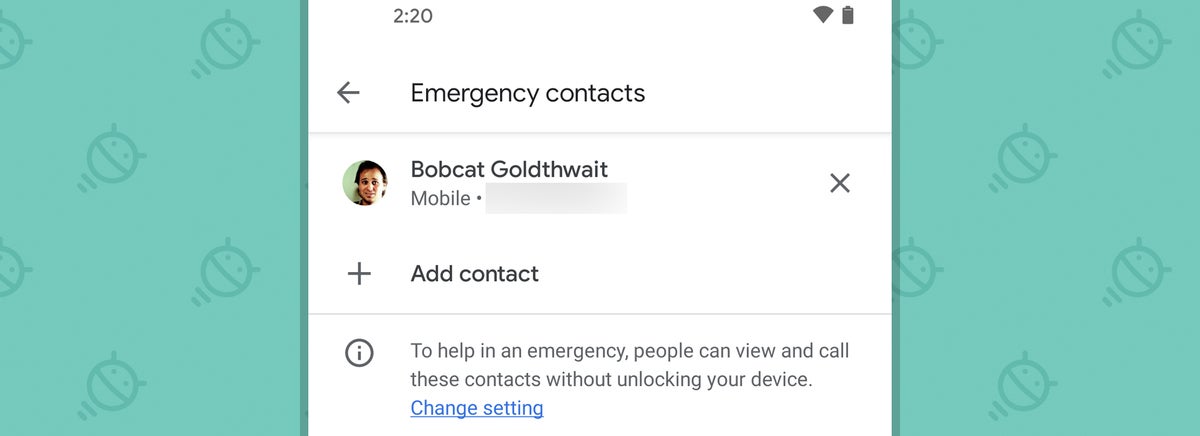 JR
JR Piece of cake peasy, right? Well, almost: The merely challenge is that the emergency contact info isn't exactly obvious or simple to notice on the lock screen — go figure — so anyone who picks upwards your phone might non even notice it.
Merely wait! You lot can increase the odds considerably with one extra footstep: Head into the Brandish section of your settings, tap "Advanced" followed by "Lock screen," then tap the line labeled "Add text on lock screen" and enter something along the lines of: "If you've found this phone, please swipe up and so tap 'Emergency' and 'View emergency data' to notify me. Give thanks you!" (Hey, it can never hurt to exist polite.)
That message will then ever show up on your lock screen — and as an added bonus, if in that location'southward ever an actual emergency, you'll be ready for that, too.
Using a Samsung telephone? For no credible reason (sensing a theme here?), Samsung has removed the direct emergency contact organisation and instead offers only the power to place plain text on your lock screen. You can observe that, though, past making your manner into the Lock Screen section of your system settings and looking for the line labeled "Contact information" — and there, you can just blazon in your emergency contact info straight and hope that someone finds information technology and then dials information technology from their ain phone.
One more than thing...
Now that you've got your Android security settings optimized and in social club, have ten minutes to perform an Android security inspect. It'due south a throughout checkup I've created for the state of security on both your phone and your broader Google account — and it's well worth doing at least once a yr.
The best part of this checkup? Information technology's completely painless — and dissimilar with most preventative exams, removing your pants is entirely optional.
Want even more Googley cognition? Sign upwardly for my weekly newsletter to go next-level tips and insight delivered directly to your inbox.

[Android Intelligence videos at Computerworld]
Copyright © 2022 IDG Communications, Inc.
How To Lock Android Phone Settings,
Source: https://www.computerworld.com/article/3268079/android-security-settings.html
Posted by: caballeroaraid1960.blogspot.com


0 Response to "How To Lock Android Phone Settings"
Post a Comment